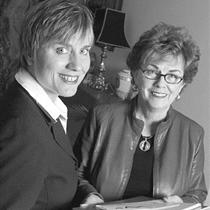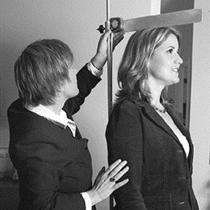|
|
Made to measure
Margo Roston,
Citizen Special Jennifer Blattman is a young professional who has never worried too much about her clothes other than making sure she has a good corporate look.
But the 30-year-old marketing project manager at the University of Ottawa jumped at the chance to try out a new fashion system that promises that, if you apply 12 measurements when fixing up or buying your clothes, you’ll look better and feel more confident. It’s all about proportion, says the promotion for Fashion Fit Formula, and the measurements are supposed to last for life, whether you gain or lose weight. Ottawa image consultants Teresa and Terry Lee McCarthy, marketing managers and trainers for the program, couldn’t wait to get out their measuring stick when they met Blattman.
The Fashion Fit Formula claims every woman has four perfect hemlines for skirts and dresses, two correct sleeve lengths, one perfect waist point and one perfect neckline point, so the first step in the program was to take Blattman’s 12 vertical measurements to calculate her personal “formula.” The system was developed many years ago by Maryland businesswoman Janet Wood. Wood tried it on her friends, but only went into business with her idea in the early 1990s. Since then, it has grown quickly among image consultants in Canada. Blattman’s measurements sounded complicated: for example, ideal neckline — 1.125 inches below the breastbone; short jacket — wear at the leg/torso joint or 34.625 inches above the floor. To skeptics this all sounds rather esoteric, but a couple of weeks after the initial measuring, the McCarthys arrived with pins and Blattman’s computerized measurements, ready to show off the program. They shortened her below-knee skirt to “street length” (also the length for short capris in the program), which meant one inch below the middle of her knee. Next they shortened her suit jacket to a “standard” jacket length of 1.875 inches below the middle knuckle of her third finger. Then they shortened her sleeves and measured her necklace, telling her it was too short because it should have reached 1.125 inches below her neckline. They showed her the proper length by adding a scarf to her outfit. The changes were subtle but telling; Blattman looked neater, crisper and more stylish. She was surprised, especially at the length of her jacket and the McCarthys’ little trick of putting the jacket pocket flaps inside the pocket for a cleaner look. “I thought a longer jacket covered my butt,” Blattman said, “but this looks better.” She was also pleased with the longer length around her neck, and listened carefully as the McCarthys suggested some ideas for shapes to suit her rectangular face: a scoop or V-neck, oval glasses and any earrings that aren’t square. “And no chokers,” the mother-daughter duo said. Blattman will get all these suggestions and more in a portfolio, which also includes a printout of her measurements and a pocket-size tape measure to take to the dressmaker or when she goes shopping. If the system sounds complicated for the average woman who wouldn’t dream of shopping with a tape measure, it’s convenient for turning those outdated clothes in the back of the cupboard into something as good as new. And there are tricks for buying new clothes using the measurements. Jennifer McFarlane, a marketing assistant at Canaccord Capital Corporation, has learned how to shop using her measurements with a neat trick. Instead of pulling out a tape measure, McFarlane makes little marks on her legs to show the perfect skirt length and on her arms where the sleeves should end. She bought into the program after hearing the McCarthys at a company seminar. “I’m a petite,” she says, “and it was particularly helpful when it came to buying shorts.” The measurements for short shorts are included in the information sheet and are the same as for a standard jacket, while Bermuda shorts are the same measurement as a three-quarter jacket or a mini-skirt. “I consider myself a nifty dresser,” McFarlane says, “but now I know what’s out of proportion. I’m very particular now about following the measurements. Not everyone knows when they see me how I buy my clothes, but they know I look nice. And it makes you feel more confident.” The McCarthys are the formula’s marketing and sales reps for Canada, as well as trainers, but there are three other consultants in the Ottawa area. The computerized portfolios have been coming from the U.S. office, but Teresa McCarthy says they’ll soon be doing the work in Canada. A full portfolio, including two visits with the consultant, measurements and a workbook along with personalized tips, costs $250 – $125 without a workbook. — Margo Roston is an Ottawa writer. Reach Teresa and Terry Lee McCarthy at Image Solutions Group, 724-1030. © The Ottawa Citizen 2005 |


